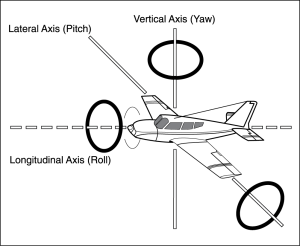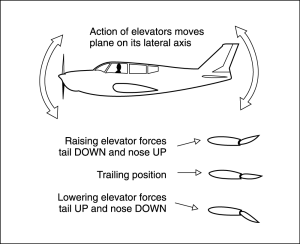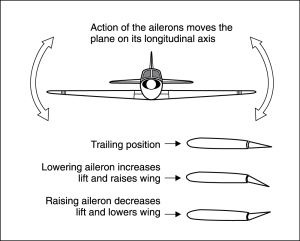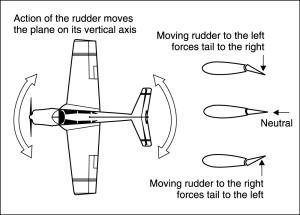In the previous week, the Learn to Fly Blog has covered the four forces in flight. To recap, these are lift, weight, thrust, and drag. These forces are key in aircraft aerodynamics and will become extremely important throughout your flight training, particularly when learning how to control the aircraft. In addition to these in-flight forces, it is important to have an understanding of the three axes around aircraft. You can think of each axis as an imaginary line passing through the aircraft’s center of gravity (CG). Anytime the aircraft changes in-flight attitude, it is moving about one or more of these axes. Below is an excerpt from ASA’s 2015 Private Pilot Test Prep containing some figures to help you understand each axis.
Aircraft have three axes of rotation: the lateral axis, longitudinal axis, and the vertical axis.

The lateral axis is an imaginary line from wing tip to wing tip for an airplane. The rotation around this axis is called pitch. Pitch is controlled by the elevators, and this rotation is referred to as longitudinal control or longitudinal stability.

The longitudinal axis is an imaginary line from the nose to the tail. Rotation around the longitudinal axis is called roll. Roll is controlled by the ailerons, and this rotation is referred to as lateral control or lateral stability.

The vertical axis is an imaginary line extending vertically through the intersection of the lateral and longitudinal axes. Rotation about the vertical axis is called yaw. Yaw is controlled by the rudder, and this rotation is referred to as directional control or directional stability.

The center of gravity (the imaginary point where all the weight is concentrated) is the point at which an airplane would balance if it were suspended at that point. The three axes intersect at the center of gravity. Weight-shift control and powered parachutes rotate around this center of gravity.
Later in the week, I will present you with some sample questions relating to the material covered in the previous few weeks. These questions will be from Chapter 1 Basic Aerodynamics of the Private Pilot Test Prep Book. Each question is very similar in nature to what you can except to see on the actual FAA Knowledge Test. Here is a teaser for next week…
What is the purpose of the rudder on an airplane?
A—To control yaw.
B—To control overbanking tendency.
C—To control roll.




